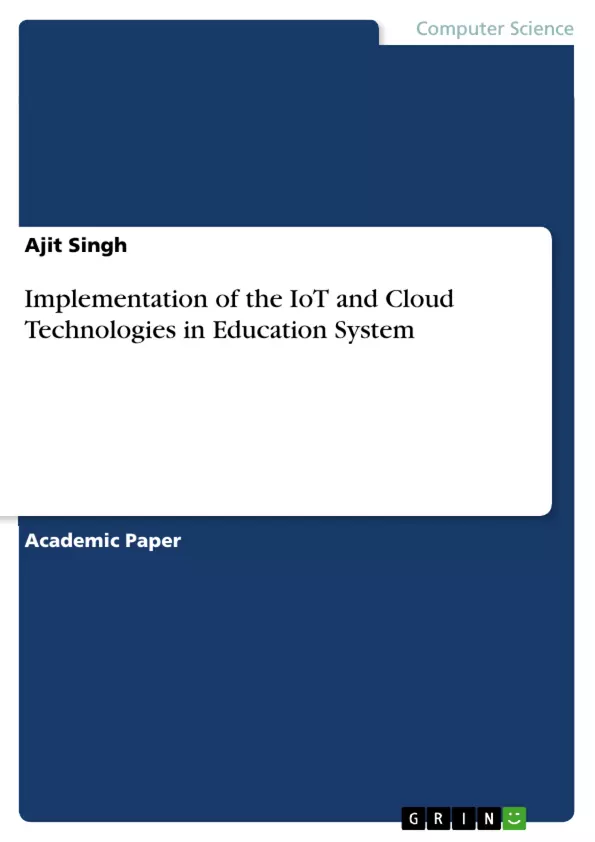The IOT and Cloud computing technologies can provide solutions for the above mentioned problems in education system. Cloud computing enables users to control and access data via the Internet. The main users of a typical higher education cloud include students, Faculty, administrative staff, Examination Branch and Admission Branch. All the main users of the institution are connected to the cloud .Separate login is provided for all the users for their respective work. Teachers can upload their class Tutorials, assignments, and tests on the cloud server which students will be able to access all the teaching material provided by the teachers via Internet using computers and other electronic devices both at home and college and 24X7. This paper focus on the integration of Cloud and IOT for education system. Connected devices can help make life easier for students with special needs. Many of the daydreams for IOT in education involve students taking advantage of new technologies to complete cool new projects.
Inhaltsverzeichnis (Table of Contents)
- I. INTRODUCTION
- II. RELATED WORK
- 2.1. Need for Implementing the IOT and Cloud Computing
- III. IMPLICATIONS OF IOT IN EDUCATION
- 3.1. The four Pillars of IOT in Education
- i. People
- ii. Process
- iii. Data
- iv. Things
- 3.2. Key Factors for Successful Implementation of IOT in Education
- IV. APPLICATIONS OF CLOUD IOT PARADIGM IN EDUCATION SYSTEM
- 4.1. Enhanced Learning Experiences and Outcomes
- 4.2. Improved Operational Efficiency
- 4.3. Safer Campus Designs
Zielsetzung und Themenschwerpunkte (Objectives and Key Themes)
This paper focuses on the integration of cloud and Internet of Things (IoT) technologies within the education system. The primary objective is to demonstrate how this integration can revolutionize teaching and learning, enhance efficiency, and improve the overall safety and security of educational institutions.
- The potential of IoT and cloud technologies to address challenges in the education system
- The four pillars of IoT in education: people, process, data, and things
- Key factors for successful implementation of IoT in education, including security, data integrity, and education policies
- Applications of the cloud-IoT paradigm in education, encompassing enhanced learning experiences, improved operational efficiency, and safer campus designs
- The benefits and risks associated with integrating IoT and cloud technologies in education
Zusammenfassung der Kapitel (Chapter Summaries)
The paper begins by introducing the evolution of the Internet and the emergence of the Internet of Things (IoT), where physical objects communicate and interact with each other. It highlights the potential of IoT to enhance research and learning, particularly within the education system.
Chapter II discusses the need for implementing IoT and cloud computing in education. It emphasizes the advantages of integrating these two technologies, including enhanced capacity, resource management, and the ability to address real-world scenarios more effectively. The chapter also underscores the importance of empowering digital citizens with the knowledge and skills necessary to navigate the ever-evolving digital landscape.
Chapter III delves into the implications of IoT in education. It examines the four pillars of IoT—people, process, data, and things—and explores their impact on learning and teaching practices. The chapter also outlines key factors for successful implementation, including security, data integrity, and education policies.
Chapter IV presents practical applications of the cloud-IoT paradigm in education. It highlights how these technologies can enhance learning experiences, improve operational efficiency, and create safer campus environments. The chapter provides specific examples of how IoT can be used to track resources, monitor student performance, and ensure student safety.
Schlüsselwörter (Keywords)
The core concepts explored in this paper include the Internet of Things (IoT), cloud computing, education system, implementation, security, data integrity, education policies, learning experiences, operational efficiency, and campus safety. It delves into the potential of integrating these technologies to address the challenges faced by modern education and create a more engaging and relevant learning environment for students.
- Quote paper
- Ajit Singh (Author), 2019, Implementation of the IoT and Cloud Technologies in Education System, Munich, GRIN Verlag, https://www.grin.com/document/488757



